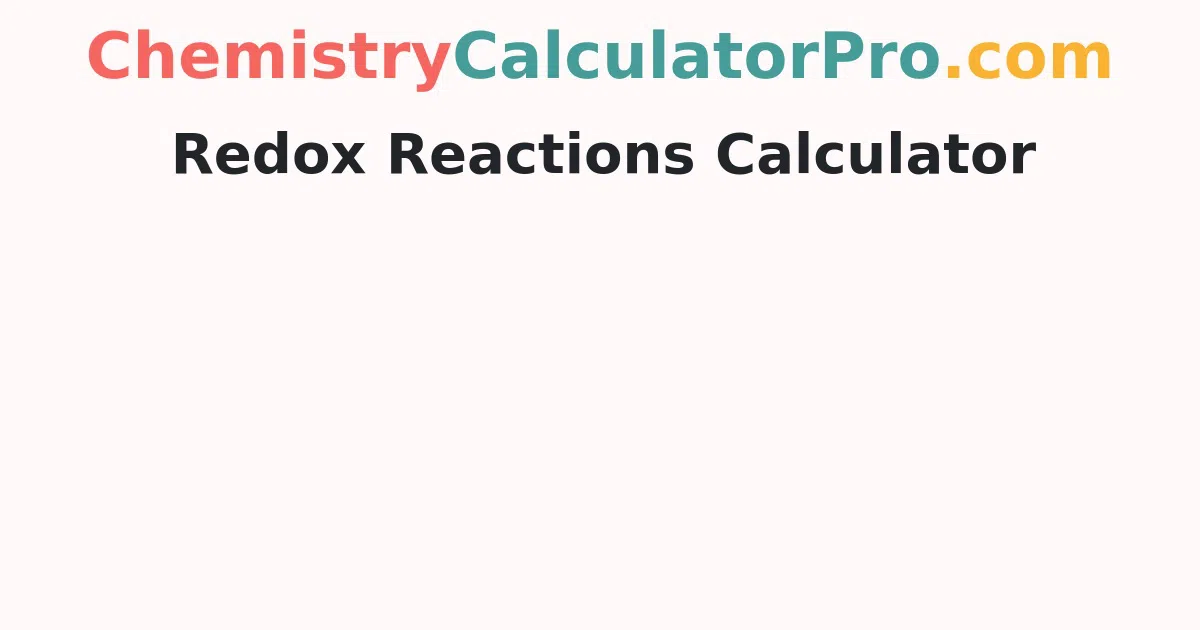Redox Reactions Calculator
The Redox Reaction Calculator is a free online tool that illustrates chemical reactions' reduction and oxidation processes. The online redox reaction calculator tool speeds up calculations and displays the redox reaction of a chemical equation in a matter of seconds.
What are Redox Reactions?
The redox reaction is the oxidation and reduction process in chemistry. The oxidation state of the reactant changes during the redox reaction process. Both the reduction and oxidation processes are carried out simultaneously in this procedure. The change in the oxidation state of the reactive element can be used to determine the electron transformation. There should be an electron loss and a rise in the oxidation state of the reactant during the oxidation process. In the reduction process, electrons are gained, and the oxidation status of the reactant is decreased.
How to Balance Redox Reactions?
You can learn how to balance redox reactions manually in addition to using a balancing redox reaction calculator. The steps of learning are listed below.
- Write a chemical equation that is imbalanced: First, write down and divide your unbalanced chemical equation into two parts. Follow the recommendations for these purposes.
- Assign each atom an oxidation state or number. If an atom's oxidation state is zero on both sides, write it down as zero.
- Identify the redox couples after that.
- Finally, in a series of half-reactions, note down the redox couple.
- Make sure each atom is in its proper place: The next step is to make sure that each atom in both half-reactions is balanced. Keep these broad guidelines in mind while balancing
- Except for oxygen and hydrogen, balance all the atoms.
- Attempt to strike a balance between the number of oxygen ions on both sides and the number of water molecules on both sides.
- Make use of H+ ions to balance hydrogen atoms.
- Insert a hydroxyl ion for each and every h+ ions on the both sides if the reaction is actually occurring in a basic medium.
- Electrons must be balanced: It's time to balance the amount of electrons on both sides after balancing the number of atoms on both sides. Note where an electron is added to a chemical and record it as electron loss on the opposite side of half-reactions.
- Make the equation easier to understand: To simplify the equation, add both half-reactions together and cancel out the identical atoms and ions. A step-by-step calculator for balancing chemical equations can assist you in balancing and simplifying the equation online. Finally, double-check whether the number of charges and elements on both sides are balanced.
How does Redox Reactions Calculator Work?
In less than a minute, this redox reaction calculator can balance any type of redox equation, complex or straightforward. However, you can only do so if you follow some basic principles while writing your equation in the bar, such as the ones below.
- The space is not counted in this redox equation balancer since it is entirely unimportant. For instance, entering Fe(CN), six will equal Fe(CN)6.
- It is not necessary to type the charges as subordinates and simply add a charge to the calculation. You can write Mn2+, Mn2++, or Hg2×2+, for Mn2+, Mn2++, or Hg2×2+, for example
- To prevent typing an error when typing the formula for a metal complex, you can use any style of bracket or parentheses. For example, if you type [Fe2(SO4)3], the redox reaction balancer will notice it
- In place of the equation symbol, you can use signs like "- - >" or "=" to distinguish the left and right sides of the reaction.
- You must accurately type the chemical symbol for each element in the composite, using uppercase and lowercase letters. The redox calculator won't recognise the compound when you write a chemical formula in all caps, such as NaOH or FeSO4
- Choose the medium in which the reaction is taking place, acidic or basic, after typing the imbalanced redox chemical equation so that the balancing redox reaction calculator can answer your solution appropriately.
FAQ’s on Redox Reaction Calculator
1. What makes a redox reaction unique?
Redox reactions have two parts: a reduced half and an oxidised half that always happen at the same time. In a redox reaction, the two species that exchange electrons are given unique names: The oxidising agent is an ion or molecule that takes electrons and thus oxidises other species by doing so.
2. How can you tell if a reaction is a redox?
In conclusion, redox processes are always identified by changing the oxidation number of two of the atoms involved. A redox reaction is one in which the oxidation levels do not change.
3. In a redox reaction, what happens?
Redox reactions, also known as oxidation-reduction processes, are reactions in which electrons are transferred from one species to another. An oxidised species loses electrons, while a reduced species obtains electrons.
4. What are the different types of redox reactions?
Combining, breakdown, relocation, combustion, and dehydrogenation are the five main types of redox processes.
